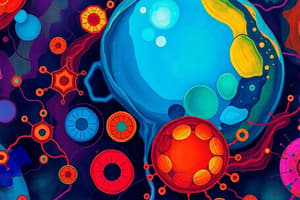Podcast
Questions and Answers
¿Cuál es la función principal de las células según el texto?
¿Cuál es la función principal de las células según el texto?
- Eliminar desechos
- Responder a estímulos
- Generar energía (correct)
- Producir proteínas
¿Qué estructura celular actúa como barrera entre el interior y el exterior de la célula?
¿Qué estructura celular actúa como barrera entre el interior y el exterior de la célula?
- Mitocondria
- Membrana plasmática (correct)
- Citoplasma
- Núcleo
¿Dónde se encuentra almacenado el material genético de la célula?
¿Dónde se encuentra almacenado el material genético de la célula?
- En los ribosomas
- En el citoplasma
- En el núcleo (correct)
- En los cloroplastos
¿Qué función desempeña el citoplasma dentro de la célula?
¿Qué función desempeña el citoplasma dentro de la célula?
¿Cuál es una característica común de todas las células mencionadas en el texto?
¿Cuál es una característica común de todas las células mencionadas en el texto?
¿Cuál es la función principal de los organelos en las células?
¿Cuál es la función principal de los organelos en las células?
¿Cuál de las siguientes afirmaciones sobre las mitocondrias es correcta?
¿Cuál de las siguientes afirmaciones sobre las mitocondrias es correcta?
¿Cuál de las siguientes funciones NO es realizada por el retículo endoplásmico?
¿Cuál de las siguientes funciones NO es realizada por el retículo endoplásmico?
¿Cuál de las siguientes estructuras celulares es responsable de la división celular y la organización del huso mitótico?
¿Cuál de las siguientes estructuras celulares es responsable de la división celular y la organización del huso mitótico?
¿Cuál de las siguientes afirmaciones sobre las células procariotas y eucariotas es FALSA?
¿Cuál de las siguientes afirmaciones sobre las células procariotas y eucariotas es FALSA?
¿Cuál de los siguientes orgánulos NO está involucrado en la síntesis de proteínas?
¿Cuál de los siguientes orgánulos NO está involucrado en la síntesis de proteínas?
Durante la división celular, ¿cuál de los siguientes eventos ocurre para asegurar que las células hijas tengan el mismo material genético que la célula madre?
Durante la división celular, ¿cuál de los siguientes eventos ocurre para asegurar que las células hijas tengan el mismo material genético que la célula madre?
Study Notes
Cells: An Insight into their Structure and Functions
Cells are the basic units of life, and they serve as the foundation for all living organisms. They come in various types, ranging from unicellular bacteria to multicelled humans and plants. Despite their differences, all cells share common characteristics, including a plasma membrane, cytoplasm, and organelles. In this article, we will explore the structure and functions of cells, focusing on cell types, organelles, and their roles in cell division.
Cell Functions
Cells perform several essential functions necessary for life, such as producing energy, creating proteins, removing waste, and responding to stimuli. These functions are achieved through the interaction of various organelles within the cell.
Cell Structure
A typical cell consists of three primary components: the plasma membrane, the cytoplasm, and the nucleus. The plasma membrane, also known as the cell membrane, surrounds the cell and serves as a barrier between the interior and exterior of the cell. The cytoplasm is the gel-like substance within the cell membrane and contains organelles suspended in it. Finally, the nucleus, located near the center of the cell, stores the cell's genetic material.
Substructures
Within the cytoplasm, there are several smaller structures called organelles, which are specialized for specific tasks. These include:
- Mitochondria: Often referred to as the powerhouses of the cell, mitochondria generate the energy required for cellular processes through the process of cellular respiration.
- Endoplasmic Reticulum (ER): The ER is involved in protein synthesis and lipid biosynthesis, while also serving as a conduit for the transportation of molecules throughout the cell.
- Ribosomes: Responsible for protein synthesis and the assembly of amino acids into peptides.
- Golgi Apparatus: The Golgi plays a key role in modifying, sorting, and packaging proteins and lipids for transport to their final destinations within the cell.
- Lysosomes: These vesicles contain enzymes that break down cellular waste, such as damaged organelles and macromolecules, through a process called autophagy.
- Cytoskeleton: A network of protein fibers that provides both structural support and facilitates cell movement.
- Centrosome: Contains microtubules and plays a crucial role in cell division and the organization of the mitotic spindle.
Cell Types
Cells can be broadly categorized into two groups: prokaryotic and eukaryotic. Prokaryotic cells lack a defined nucleus and do not contain internal membranes, while eukaryotic cells have a true nucleus and possess multiple membrane-bound organelles.
Cell Organelles
As mentioned earlier, eukaryotic cells contain various membrane-bound and non-membrane-bound organelles that perform specific functions. Membrane-bound organelles include the nucleus, mitochondria, chloroplasts, and the endoplasmic reticulum. Non-membrane-bound organelles consist of the ribosomes and the cytoskeleton.
Cell Division
Cell division refers to the process by which a single cell splits into two daughter cells. During this process, the cell's genetic material is duplicated and distributed equally among the daughter cells, ensuring that each new cell inherits the same genetic makeup as the parent cell.
In summary, cells are the fundamental units of life, and they exhibit diverse structures and functions tailored to their respective roles in living organisms. From the smallest prokaryotic cells to the most complex eukaryotic cells, all cells rely on a combination of organelles and specialized structures to maintain their vitality and perform the myriad functions necessary for life.
Studying That Suits You
Use AI to generate personalized quizzes and flashcards to suit your learning preferences.
Description
Descubre la estructura y funciones de las células, desde la membrana plasmática hasta los organelos especializados. Aprende sobre los tipos de células, como las procariotas y eucariotas, y el proceso de división celular. Explora cómo las células generan energía, producen proteínas y responden a estímulos a través de sus organelos.




